
Academy 1/48 F-4C Phantom II
| KIT #: | 12294 |
| PRICE: | $91.00 SRP |
| DECALS: | One option |
| REVIEWER: | Blair Stewart |
| NOTES: | Multiple ordnance options |

| HISTORY |
The McDonnell Douglas F-4 Phantom II is an American tandem two-seat, twin-engine, all-weather, long-range supersonic jet interceptor and and fighter-bomber originally developed by McDonnell Aircraft for the United States Navy. It entered service with the Navy in 1961 before it was adopted by the United States Marine Corps and the United States Air Force, and by the mid-1960s it had become a major part of their air arms. Phantom production ran from 1958 to 1981 with a total of 5,195 aircraft built, making it the most produced American supersonic military aircraft in history.
The Phantom is a large fighter with a top speed of over Mach 2.2. It can carry more than 18,000 pounds (8,400 kg) of weapons on nine external hardpoints, including air-to-air missiles, air-to-ground missiles, and various bombs. The F-4 was initially designed without an internal cannon. Later models (i.e., the F-4E) incorporated an M61 Vulcan rotary cannon.
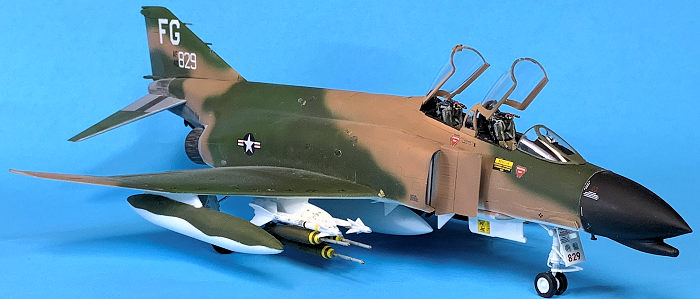 The F-4 was
used extensively during the Vietnam War. The early Air Force model – the F-4C –
gained its initial notoriety because of aerial combat victories scored by crews
of the 8th Tactical Fighter Wing stationed at Ubon Royal Thai Air Force Base.
The F-4 was
used extensively during the Vietnam War. The early Air Force model – the F-4C –
gained its initial notoriety because of aerial combat victories scored by crews
of the 8th Tactical Fighter Wing stationed at Ubon Royal Thai Air Force Base.
On September 30, 1966, Colonel Robin Olds, a WWII ace with 13 kills, took command of the 8th Tactical Fighter Wing. (Note: Olds was the only pilot to become an ace in both the P-38 [5 victories] and the P-51 [8 victories]). A lack of aggressiveness and sense of purpose in the wing had led to the change in command (Olds' predecessor had flown only 12 missions during the 10 months the wing had been in combat). The 44-year-old colonel also set the tone for his command stint by immediately placing himself on the flight schedule as a rookie pilot under officers junior to himself, then challenging them to train him properly because he would soon be leading them.
Olds' vice commander was Col. Vermont Garrison, an ace in both World War II and Korea, and in December Olds brought in Daniel James Jr. to replace an ineffective deputy commander for operations, creating arguably the strongest and most effective tactical command triumvirate of the Vietnam War. The Olds-James combination became popularly known as "Blackman and Robin". James was named 8th TFW Vice Commander in June 1967, succeeding Garrison, who had completed his tour. Olds took to the air war over North Vietnam in an F-4C Phantom he nicknamed "Scat XXVII", in keeping with his previous combat aircraft that all carried the "Scat" name.
During 1966, the F-105 Thunderchief was flying the lion’s share of Air Force bombing missions into North Vietnam, particularly the Hanoi and Haiphong areas. The F-105s were sustaining heavy losses, particularly during the Operation Rolling Thunder aerial-bombardment campaign. Vietnam People's Air Force fighter jets – notably Mig-21s - had evaded U.S. escort fighters and attacked U.S. bombers flying predictable routes.
The F-105 missions had become predictable because they consisted of large formation strikes from Thailand flying roughly the same routes and times of day. This allowed the Vietnamese People’s Air Force (VPAF) to challenge them with a relatively small force of 15 or 16 MiG-21 fighters used as point defense interceptors. The relatively agile Mig-21s became a huge threat to the comparatively sluggish, bomb-laden F-105 fighter-bombers. The USAF pilots were constrained by their rules of engagement and thwarted by an adversary that only engaged when the situation was ideal.
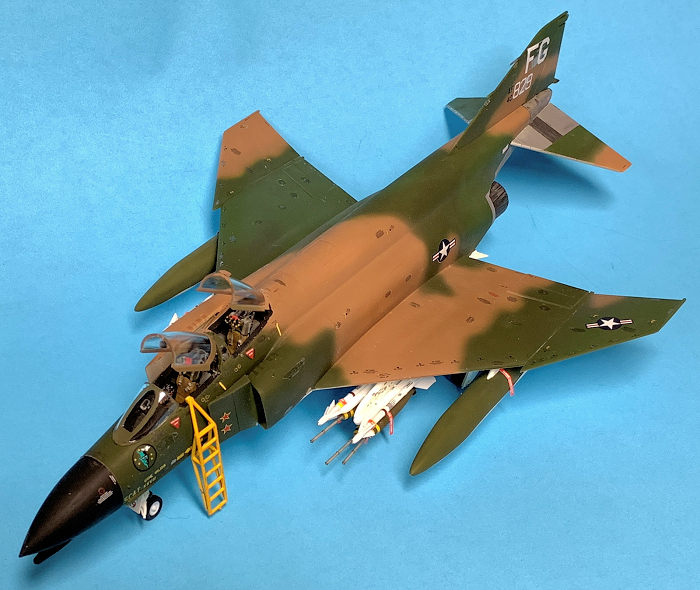 Robin Olds
devised "Operation Bolo" to deal with the new MiG threat. Since October the
F-105s had been equipped with QRC-160 radar jamming pods that had virtually
ended their own losses to surface-to-air missiles, but had shifted SAM attacks
to Air Force Phantoms, unprotected because of a shortage of the pods. Rules of
engagement that had previously permitted the F-4 MiGCAP to escort the F-105s in
and out of the target area had been revised in December to limit MiGCAP
penetration to the edge of SAM coverage. MiG interceptions had consequently
increased, primarily due to MiG-21s using high-speed hit-and-run tactics against
bomb-laden F-105 formations, and although only two bombers had been lost, the
threat to the force was perceived as serious. Bombing of North Vietnamese
airfields was still forbidden at the start of 1967, and 8th TFW wing commander
Col. Olds proposed an aerial ambush as the best means of mitigating the threat.
Robin Olds
devised "Operation Bolo" to deal with the new MiG threat. Since October the
F-105s had been equipped with QRC-160 radar jamming pods that had virtually
ended their own losses to surface-to-air missiles, but had shifted SAM attacks
to Air Force Phantoms, unprotected because of a shortage of the pods. Rules of
engagement that had previously permitted the F-4 MiGCAP to escort the F-105s in
and out of the target area had been revised in December to limit MiGCAP
penetration to the edge of SAM coverage. MiG interceptions had consequently
increased, primarily due to MiG-21s using high-speed hit-and-run tactics against
bomb-laden F-105 formations, and although only two bombers had been lost, the
threat to the force was perceived as serious. Bombing of North Vietnamese
airfields was still forbidden at the start of 1967, and 8th TFW wing commander
Col. Olds proposed an aerial ambush as the best means of mitigating the threat.
Olds and some hand-selected junior officers planned for a coordinated mission by a "west force" of seven flights of F-4Cs from the 8th TFW at Ubon and an "east force" of seven flights of F-4Cs from the 366th Tactical Fighter Wing based at Da Nang Air Base, South Vietnam. The west force would simulate the F-105 strike force while the east force would cover alternate airfields and provide a barrier against MiGs attempting to flee to China. The task force also included 6 flights of F-105s for protection from SAMs, airborne radar support by College Eye EC-121aircraft, and radar jamming support by EB-66s, escorted by four flights of F-104s of the 435th TFS at Ubon.
On January 2, 1967, the 8th Tac Fighter Wing executed the mission, and as planned, the VPAF fell for it. Of the 16 MiG-21s known to be in the VPAF inventory, 11 to 14 had been engaged on that day (depending on the source), with seven destroyed and two others probably shot down. Robin Olds claimed one of the kills – his first of four during his Vietnam tour. Years later, Vietnamese government sources admitted that Operation Bolo on January 2 was one of the worst days for the VPAF during the war. The VPAF claimed to have lost five MiG-21s, with no enemy kills to claim. On January 5 and 6, the 555th Fighter Squadron flew a similar “ruse” mission with F-4Cs disguised as RF-4Cs. On the second day, the F-4Cs shot down two more Mig-21s.
For the North Vietnamese (and their Soviet allies who supplied the MiG-21 aircraft and helped set up the integrated air defense network), the two reverses on January 2 and January 5–6 forced them to disband their assets by grounding the MiGs for four months for retraining and devising of new tactics.
Today, Robin Olds’ Scat XXVII F-4C, tail number 40829, is on display at the National Museum of the United States Air Force, exhibiting two Mig kills on its port intake splitter.
| THE KIT |
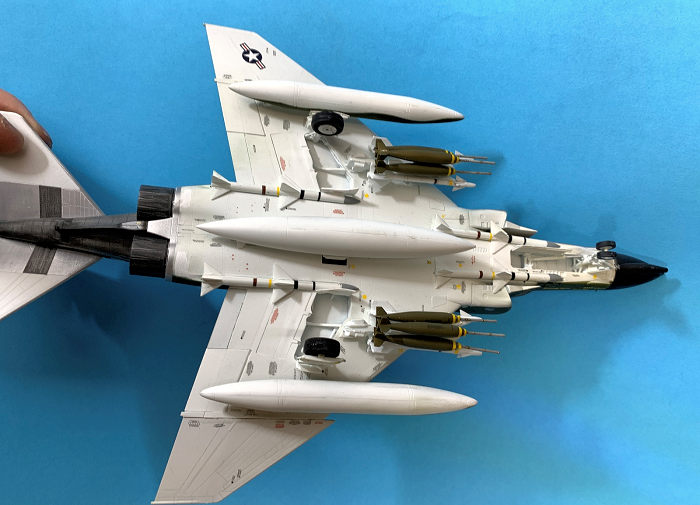 This is
Academy’s follow-on to its 2012 release of kit no. 12232, 1/48 scale F-4B
“VF-111 Sundowners.” I started this kit when it first came out, and after a
particularly acute case of advanced modeling syndrome, I put it on the shelf. I
finally finished it early this year and was really impressed with the kit. I
know the new Tamiya F-4B is supposed to be the cat’s meow, but these Academy F-4
kits hold their own, especially given that they are less expensive, and include
tons of ordnance (missiles and bombs). When Academy finally released an Air
Force F-4C, I couldn’t resist buying it – particularly since in 1967 I had
gotten a great ride at Eglin AFB in an F-4E (we even went on the Hurlburt Field
bombing range and shot the internal M-61 Vulcan cannon!).
This is
Academy’s follow-on to its 2012 release of kit no. 12232, 1/48 scale F-4B
“VF-111 Sundowners.” I started this kit when it first came out, and after a
particularly acute case of advanced modeling syndrome, I put it on the shelf. I
finally finished it early this year and was really impressed with the kit. I
know the new Tamiya F-4B is supposed to be the cat’s meow, but these Academy F-4
kits hold their own, especially given that they are less expensive, and include
tons of ordnance (missiles and bombs). When Academy finally released an Air
Force F-4C, I couldn’t resist buying it – particularly since in 1967 I had
gotten a great ride at Eglin AFB in an F-4E (we even went on the Hurlburt Field
bombing range and shot the internal M-61 Vulcan cannon!).
On opening the box, one is greeted by a huge number of sprues (15). The upper fuselage is molded in one piece. The biggest “negative” comment I have read about this kit is the attempt by Academy to provide sprues in black, gray and white plastic. I suppose they believed some younger modelers might assemble the kit without having to paint some of the features (e.g., landing gear and tires), but I can’t figure out how they thought this was a plus.
As stated above, a huge bonus is the number of missiles, bombs, drop tanks, and weapons pylons that are included in the kit. There are four AIM-7 Sparrows, four each of three different models of the AIM-9 Sidewinder (and to satisfy the “close observers” – AKA rivet counters - one needs to be careful to pick a Sidewinder version, such as the AIM-9B, that was actually being used on F-4Cs during the mid-sixties), 12 Mk82 500 pound bombs – including optional fuse extenders – and an SUU-23 M61 Vulcan under-wing gun pod.
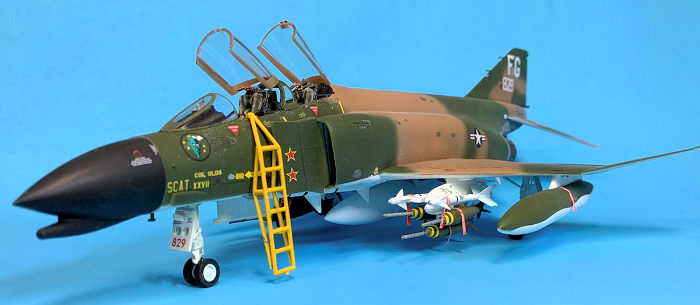 The cockpit
is nicely detailed, and pops with some careful painting. Even though the kit
ejection seats are not bad, I opted to use Legend’s 1/48 Martin-Baker Ejection
Seat Set with Seat Belts (no. LF4002). Note that these are MK. H-7 seats. Some
early Phantoms were fitted with Mk. H-5 seats, and there are some slight
differences. These resin seats DO NOT come with the overhead pull handles (don’t
ask me why), so I used the kit’s plastic handles instead.
The cockpit
is nicely detailed, and pops with some careful painting. Even though the kit
ejection seats are not bad, I opted to use Legend’s 1/48 Martin-Baker Ejection
Seat Set with Seat Belts (no. LF4002). Note that these are MK. H-7 seats. Some
early Phantoms were fitted with Mk. H-5 seats, and there are some slight
differences. These resin seats DO NOT come with the overhead pull handles (don’t
ask me why), so I used the kit’s plastic handles instead.
One will also note that there are plenty of “left-over” parts (e.g., a different radome, several radome chin pods and vertical fin caps, and unslotted stabilators - some of which are shared with other F-4 versions such as the F-4B, F-4D and F-4J). Unique to this F-4C kit are the upper wings with appropriate bulges, a different vertical stabilizer, and appropriate Air Force weapons pylons for the inboard wing stations. The kit comes with two seated pilot figures and one standing figure.
As in its F-4B, Academy only provides one set of decal markings. These are for Robin Old’s Scat XXVII, serial number 40829. Academy includes a 7-page instruction booklet, a very nice two-sided color rendition showing decal placement, and a drawing showing ordnance and drop tank configurations.
| CONSTRUCTION |
Construction started with the cockpit tub and nose gear bay. Once finished, these are glued together and cemented to the lower front fuselage. I then assembled the two landing gear bays. A possible pitfall is at this point the instructions call for assembling the landing gear into the wheel wells. Normally, this just begs for breaking the landing gear at some point in the assembly process. But given the way they are secured into the wells, I threw caution to the wind and assembled the gear as instructed (fortunately, I was able to avoid breaking the gear for the entire process: a first for me!).
The next steps included
mounting the wing wheel wells to the lower wing assembly, gluing the upper wing
halves to the lower wing, assembly the air intake and engine exhaust cones, and
mounting these to the lower wing assembly. At this stage, I glued the front
lower fuselage containing the cockpit and front wheel
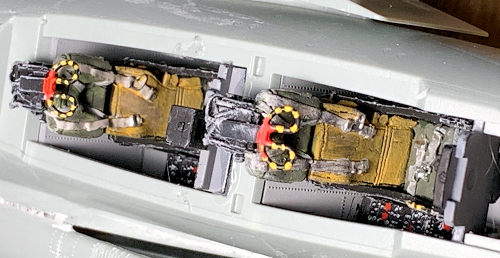 well to
the lower wing assembly. A word of caution: before gluing the upper wing halves,
you must punch holes in the lower wing assembly to accommodate any ordnance
pylons or drop tanks you wish to include on your model. I missed the holes for
the centerline tank/ triple ejector rack, so I had to measure and drill these
from the outside of the wing assembly after I had assembled and painted the
model – a dicey procedure to say the least! Once these steps were completed, I
glued the upper fuselage to the lower fuselage and wing assembly.
well to
the lower wing assembly. A word of caution: before gluing the upper wing halves,
you must punch holes in the lower wing assembly to accommodate any ordnance
pylons or drop tanks you wish to include on your model. I missed the holes for
the centerline tank/ triple ejector rack, so I had to measure and drill these
from the outside of the wing assembly after I had assembled and painted the
model – a dicey procedure to say the least! Once these steps were completed, I
glued the upper fuselage to the lower fuselage and wing assembly.
At this stage, I ran into the most troubling aspect of the assembly process: the air intakes. The fit of the air intakes can be troublesome and resulted in a lot of filling and sanding to get them to flow with the fuselage. Another area requiring filling and sanding was the seam for the front lower fuselage where it mates to the lower wing assembly. Finally, I had to use some putty and sanding where the upper fuselage mates to the lower wing assembly and front lower fuselage.
The next steps involve assembling and mounting the wing tips, flaps and stabilators. The vertical stabilizer contains five parts and once assembled is glued to the upper fuselage. The final assembly process was for the ordnance. Assembly, painting and decaling these took a long time, but the results are well worth the effort.
In the next stage, I glued the assembled nose gear into the wheel well and glued the various gear doors to the aircraft. Finally, I assembled and painted the two Legend ejection seats and installed them in the cockpit tub (fortunately, this can be done from the top of the assembled kit, so it can be left until the very end of the assembly process).
| COLORS & MARKINGS |
The standard USAF Vietnam camo scheme consisted of FS 34079 dark green, FS34102 medium green, and FS30219 dark tan upper fuselage/vertical tail colors with an FS 36622 gray underside. I still had all these colors in Testors Model Master paints, so that is what I used. I free-handed the camo scheme with my Iwata Eclipse HP-CS airbrush. I used various Model Master metallic paints for the exhaust cones and bare metal areas on the stabilators and underneath the rear fuselage.
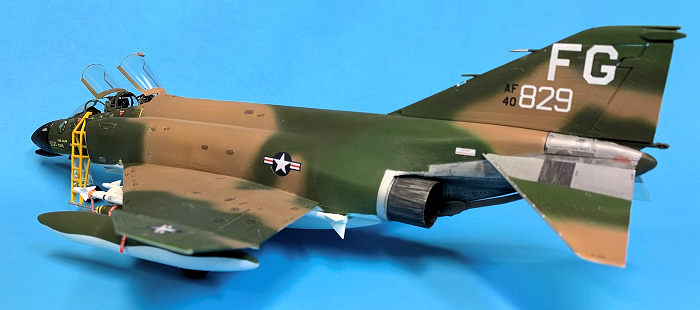 The next
most tedious activity was decaling the model. The decals are nice and thin, but
they are extensive when you attempt to include all the maintenance stenciling.
One problem I encountered after the fact: I had not laid down a sufficient gloss
surface (using Testors Glosscote), so some of the stenciling silvered. Oh well:
even longtime modelers (70-plus years of model building) like me are prone at
any moment to make mistakes. Unfortunately, this one would be difficult to
correct, so I opted to live with it.
The next
most tedious activity was decaling the model. The decals are nice and thin, but
they are extensive when you attempt to include all the maintenance stenciling.
One problem I encountered after the fact: I had not laid down a sufficient gloss
surface (using Testors Glosscote), so some of the stenciling silvered. Oh well:
even longtime modelers (70-plus years of model building) like me are prone at
any moment to make mistakes. Unfortunately, this one would be difficult to
correct, so I opted to live with it.
As a final touch, I added some P.P. Aeroparts 1/48 scale “remove before flight” tags on the drop tanks and ordnance. I also added a boarding ladder (although I recognize this is not the style of ladder the USAF used in Vietnam).
| CONCLUSIONS |
This is a great kit. While there are some fit issues, the sheer number of well-molded parts builds into a fitting replica of the venerable F-4C. I highly recommend you purchase and build one if you are an enthusiast for USAF Vietnam-era jet aircraft!
| REFERENCES |
“McDonnell Douglas F-4 Phantom II,” Wikipedia, worldwide web, December 2023.
“Robin Olds,” Wikipedia, worldwide web, December 2023.
“Operation Bolo,” Wikipedia, worldwide web, December 2023.
“McDonnell Douglas F-4C Phantom II,” National Museum of the USAF, worldwide web, December 2023.
9 January 2024
Copyright ModelingMadness.com. All rights reserved. No reproduction in part or in whole without express permission.
If you would like your product reviewed fairly and fairly quickly, please contact the editor or see other details in the Note to Contributors.